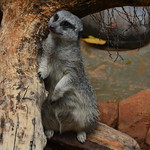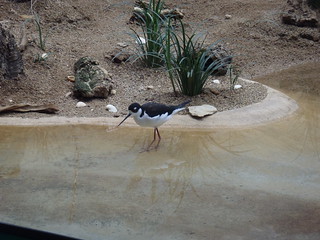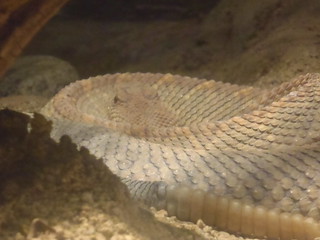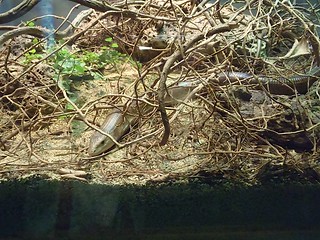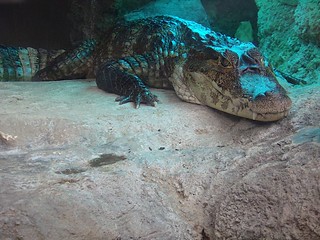Tag Archives: zoo
Lincoln Park Zoo, June 16, 2013
Lincoln Park Zoo, September 29, 2012
Lincoln Park Zoo meerkats, October 6, 2011
Milwaukee County Zoo, Boerner Botanical Gardens, falconry
Lincoln Park Zoo boardwalk, July 4, 2011
Lincoln Park Zoo, June 24, 2011
Springtime at Lincoln Park Zoo
Starting next week, my life will take another turn, so on Monday the 21st I met JT at the Lincoln Park Conservatory for Mission: Eurasian Lynx, Lincoln Park Zoo’s latest feline addition. First, however, we roamed the conservatory, focusing on the “Cretaceous Chorus” wafting among the ferns.
At the zoo, the black rhino seemed unimpressed by the yard improvements, while the polar bear was nowhere to be seen in its outdoor exhibit. At Regenstein African Journey, the African dwarf crocodile peered over a crowd of fish that obscured her submerged body. We had better luck outdoors, where we found an Andean bear swatting a suspended container, then foraging underneath it. Finally, he came to rest in a picture-perfect model’s pose by the exhibit’s pool. Further south, the spring sunshine shone on the African wild dogs’ beautiful coats.
At the McCormick Bird House, we watched as the male fairy bluebird preened himself, the shorebirds foraged in the water, the tawny frogmouth perched (and probably slept), the Inca terns checked us out, and the kookaburras perched (but didn’t sleep).
Nearby at Regenstein Birds of Prey, one of the cinereous vultures carried large twigs around somewhat officiously. The real attention getters, though, were they European white storks, whose neck-dipping, bill-clattering displays drew in even casual passers-by. Time will tell if the storks deliver baby storks.
We headed to the Kovler Penguin-Seabird House, where a molting rockhopper dueled with a sleeker neighbor. On the seabird side, a murre flapped its wings at the glass, startling a little girl who ran screaming to Mommy. Thus begins a lifelong terror of birds.
Across the way at the Kovler Lion House, Adelor the male African lion deftly maneuvered the female into a corner, where she lay down for a catnap. He paced, rubbing the left side of his face obsessively on the wires. JT said his left eye appeared to be bothering him, but I couldn’t see any inflammation or drainage. On one pass, though, I spotted the trouble. He has a well-developed cataract and is probably trying to clear his clouded vision. I remember Adelor’s arrival at the zoo when he was just a scruffy youngster, but that was many years ago, and his age is showing.
We’d been hoping the Eurasian lynx would be outdoors, but they were lazing around inside. One sister was nearly invisible on top of the rock wall, while the other’s front half was visible as she lay behind rocks on the opposite side. Mission: Eurasian Lynx was only partly successful. We saw them, but not in the best light.
We headed straight for the white-cheeked gibbon exhibit at the Brach Primate House, where a crowd had gathered. Male Caruso sat center and center as is his wont, but this time female Burma was out of hiding with her infant, born in January. She pawed at it, carried it to the wall, and returned to her original spot. The infant alternated between clinging and nursing and letting go somewhat adventurously, which may explain the pawing. When it held out its arms, we got a good look at its curved hands and long fingers — it’s truly built for a life in the trees.
At some point, the usually placid Caruso slammed into the glass, displayed an impressive set of teeth (including prominent canines), and began urinating on the glass. Highly agitated, he grabbed a vine and swung, spraying a steady stream of urine in an arc on the glass. He displayed at least twice more, minus the urine marking. He was reacting to a particular young women, who, when she realized she was the cause, sensibly stood back. Dressed in black, she was about the same height as the elevated Caruso, and her hair was streaked dark brown and blond. I heard her say that he must think she’s from a different monkey tribe. Aside from the “monkey” bit, she could be right; he may have perceived her as another primate with strangely striped head markings. All I can say is, “My, Caruso, what large, healthy teeth you have.”
By now the lakefront temperatures had dipped significantly, so, after checking out the impressive rack on the reclining Père David’s deer, we went to R. J. Grunt’s, where I recommend the raspberry shake with low-fat yogurt. Mmmm.
A winter’s day at Lincoln Park Zoo
On Wednesday, January 26, I met JT at Lincoln Park Zoo, which is small enough to be a great place to spend time in the winter. Dressing appropriately is the toughest part. If you dress too warmly, you’ll overheat in the efficiently heated buildings. If you dress too lightly, you’ll find that the walk between buildings is longer than you remember.
With few people about, the zoo is yours to savor at your own speed on a January weekday. For the animals, the quiet and the dearth of peering primate faces must seem like a vacation away from the madding crowd, a time to rest and relax before more spring fever and weather draws out the mobs.
On this day, many of the herps were front and center in their exhibits, as were the birds. Even the sometimes elusive sand cat was out of hiding, so comfortable in the relative quiet of the house that it was giving itself a top-to-tail cleaning in cat fashion. In the Ecosystem, the spectacled caiman basked under his heat lamp.
The primary objective of the visit was out of sight when we arrived at the Brach Primate House, and we were sure we wouldn’t see it. But, just as we’d given up, Burma the white-cheeked gibbon made a brief appearance, her infant clinging to her. She looked out for a moment, then sank into a depression in the back of the exhibit, from where only her shoulders and face were visible, the little one hidden below. Caruso, neglected as new fathers often are, played to his audience of three, first to me, then to a younger, thinner woman. Typical male! We did get a glimpse of the wee gibbon, with its pink face and large, fuzzy (not furry) head, but Burma didn’t hang around long enough for a photo.
After watching a cinereous vulture drive off a flock of starlings and overstaying our welcome in the McCormick Bird House (zoo buildings close early in winter), we headed across the street to R.J. Grunts, just in time to beat the crowd and to get a brown cow and a trio of tuna melts. Mmmm, mmmm, good — comfort food to warm up with.
Late spring at Lincoln Park Zoo, Chicago
Lured by stories of a Grèvy’s zebra birth and other happenings, fellow former docent and Ark editor JT and I met at Union Station for a trip to Lincoln Park Zoo. My borrowed camera and rusty skills don’t do the animals justice, so I recommend that you pay them a visit if you can — soon, before they’re all grown up. After all, the Grèvy’s zebra foal is the first edition since 2001.
We strolled the Children’s Zoo gardens, where not much was in evidence. At last, a resplendent male wood duck sailed past the beaver viewing window, his colors glowing like jewels in the midday sun. You’ll have to take my word for this; unbeknownst to me, the camera had flipped itself to TV mode, so all the photos I thought I was taking were black.

The highlight inside, however, at least to me, was this pair of walking sticks engaged in arthropod love. As a child, I was always thrilled when my brother or I (usually him) would find walking sticks in our yard, often on my dad’s tool shed, where they were easier to spot. They fascinated me, even if they did no more than take a few steps and look like a stick clinging to a shed.

At the Lion House, elderly Afghanistan leopard Christian was taking a catnap. If you want to see animals in action, early morning/late afternoon/evening during summer hours are the best times.
At the Primate House, the black howler monkeys demonstrated their prehensile tails, wrapping them around nearby branches as a stabilizing anchor. One hung by its tail over a food dish, leaving his hands free to rummage through the goodies. Don’t make the mistake one visitor did — those small monkeys who share the exhibit are not baby howlers; they’re Goeldi’s monkeys.
As usual, the black-and-white colobus monkeys were lined up on a branch, quietly digesting in dignity, even as the Allen’s swamp monkey juveniles wrestled and raced their way around the exhibit.

At Antelope/Zebra, the star is Enzi, the Grèvy’s zebra colt, who was lying down when we arrived but then untangled his gangly legs to nurse. When his mother, Adia, went over to the exhibit door to investigate keeper noise, he followed her, but turned around and walked a little distance away from the safety of his mother’s side. JT pointed out to him that, if they were in Africa, his mother would not allow him to be so bold.


The white-lipped deer were taking a rest. For one thing, I imagine it takes energy and resources to grow a rack like that, still in velvet.
The Bactrian camels were shedding. The Bactrian camels are always shedding.
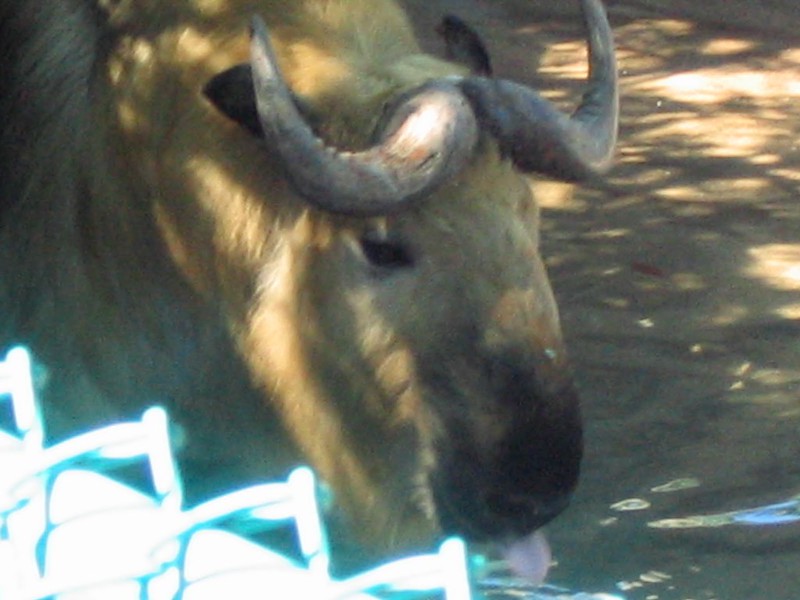
One of my favorite animals, the Sichuan takin, couldn’t decided whether to take a bath, check out the visitors (or the foliage), or scratch his face, so he did all three in a cycle, playing with something in the water (perhaps an aerator) that probably wasn’t intended for takin enrichment. He butted his impressive head against the green wire around the edge, giving us a good look at his face. I gather that the combination of strength and agility makes takins potential escape artists. This guy is among the more charismatic hoofed animals of the collection.
New on exhibit at the Small Mammal-Reptile House is the caiman lizard. I didn’t get a photo, but he’s beautiful, a bit like a combination iguana and small dinosaur with a huge head. I’m told he’s a snail eater.

The bats were more active than usual; perhaps their feeders had just been refilled. Nearby, this sand cat was relaxed. I apologized to him profusely for accidentally letting the flash go off. Within five minutes he was up and about, looking almost like a tiny house cat with an oversized head.

This is a young African dwarf crocodile, one of five produced by the recently deceased R1 late in his long life and his younger mate and occasional sparring partner Maggie. Sure, it looks sweet now, but you wouldn’t want to meet it in a few years.

At the Bird House, the tawny frogmouths demonstrate camouflage. I almost missed the one lying down. Like many owls, they blend in with tree bark, but they aren’t owls — they’re in the nightjar/oilbird order. Think of the superbly camouflaged whippoorwill, which you may hear but rarely see.

This snowy egret gave us a good look at its slender form and elegant plumage. While I might understand the appeal of their feathers as adornment, I can’t conceive of how men slaughtered them en masse in cold blood for the sake of greed. J and I have seen them in the wild, so to speak, at Volo Bog, where there was a small flock a few weeks ago.

When the European stork isn’t dropping off babies to expectant parents, it’s tending its own nest. These three chicks hatched in late May, along with a cinereous vulture chick.
Happy Father’s Day to the storks and all the zoo parents.

